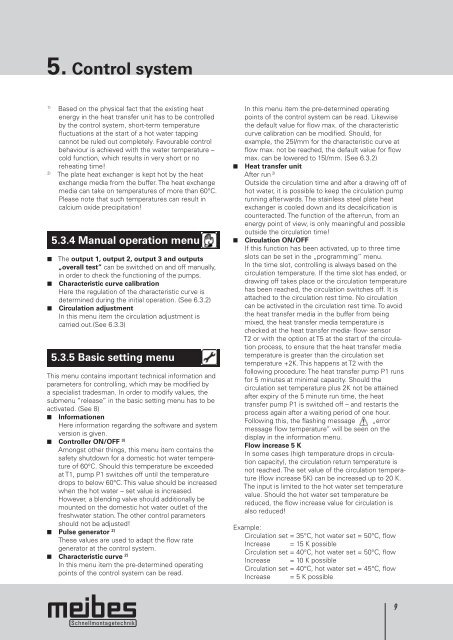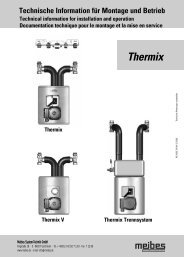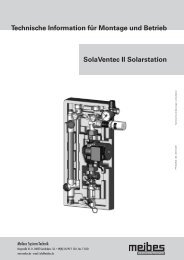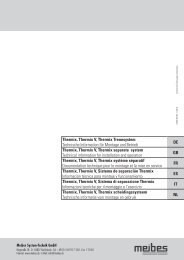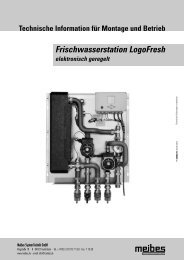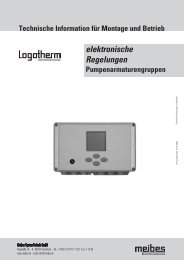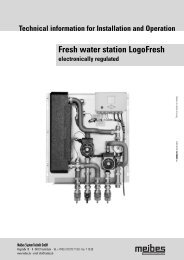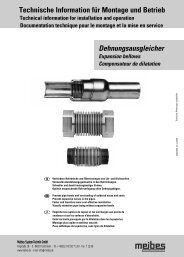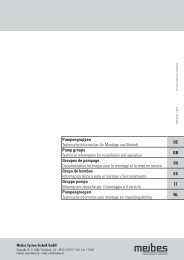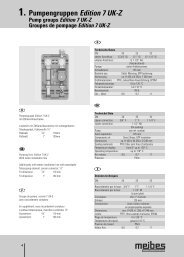5.Control system - Meibes
5.Control system - Meibes
5.Control system - Meibes
You also want an ePaper? Increase the reach of your titles
YUMPU automatically turns print PDFs into web optimized ePapers that Google loves.
5. Control <strong>system</strong><br />
1) Based on the physical fact that the existing heat<br />
energy in the heat transfer unit has to be controlled<br />
by the control <strong>system</strong>, short-term temperature<br />
fluctuations at the start of a hot water tapping<br />
cannot be ruled out completely. Favourable control<br />
behaviour is achieved with the water temperature –<br />
cold function, which results in very short or no<br />
reheating time!<br />
2) The plate heat exchanger is kept hot by the heat<br />
exchange media from the buffer. The heat exchange<br />
media can take on temperatures of more than 60°C.<br />
Please note that such temperatures can result in<br />
calcium oxide precipitation!<br />
5.3.4 Manual operation menu<br />
■ The output 1, output 2, output 3 and outputs<br />
„overall test” can be switched on and off manually,<br />
in order to check the functioning of the pumps.<br />
■ Characteristic curve calibration<br />
Here the regulation of the characteristic curve is<br />
determined during the initial operation. (See 6.3.2)<br />
■ Circulation adjustment<br />
In this menu item the circulation adjustment is<br />
carried out.(See 6.3.3)<br />
5.3.5 Basic setting menu<br />
This menu contains important technical information and<br />
parameters for controlling, which may be modified by<br />
a specialist tradesman. In order to modify values, the<br />
submenu “release” in the basic setting menu has to be<br />
activated. (See 8)<br />
■ Informationen<br />
Here information regarding the software and <strong>system</strong><br />
version is given.<br />
■ Controller ON/OFF 3)<br />
Amongst other things, this menu item contains the<br />
safety shutdown for a domestic hot water temperature<br />
of 60°C. Should this temperature be exceeded<br />
at T1, pump P1 switches off until the temperature<br />
drops to below 60°C. This value should be increased<br />
when the hot water – set value is increased.<br />
However, a blending valve should additionally be<br />
mounted on the domestic hot water outlet of the<br />
freshwater station. The other control parameters<br />
should not be adjusted!<br />
■ Pulse generator 2)<br />
These values are used to adapt the flow rate<br />
generator at the control <strong>system</strong>.<br />
■ Characteristic curve 2)<br />
In this menu item the pre-determined operating<br />
points of the control <strong>system</strong> can be read.<br />
In this menu item the pre-determined operating<br />
points of the control <strong>system</strong> can be read. Likewise<br />
the default value for flow max. of the characteristic<br />
curve calibration can be modified. Should, for<br />
example, the 25l/mm for the characteristic curve at<br />
flow max. not be reached, the default value for flow<br />
max. can be lowered to 15l/mm. (See 6.3.2)<br />
■ Heat transfer unit<br />
After run 2)<br />
Outside the circulation time and after a drawing off of<br />
hot water, it is possible to keep the circulation pump<br />
running afterwards. The stainless steel plate heat<br />
exchanger is cooled down and its decalcification is<br />
counteracted. The function of the after-run, from an<br />
energy point of view, is only meaningful and possible<br />
outside the circulation time!<br />
■ Circulation ON/OFF<br />
If this function has been activated, up to three time<br />
slots can be set in the „programming” menu.<br />
In the time slot, controlling is always based on the<br />
circulation temperature. If the time slot has ended, or<br />
drawing off takes place or the circulation temperature<br />
has been reached, the circulation switches off. It is<br />
attached to the circulation rest time. No circulation<br />
can be activated in the circulation rest time. To avoid<br />
the heat transfer media in the buffer from being<br />
mixed, the heat transfer media temperature is<br />
checked at the heat transfer media- flow- sensor<br />
T2 or with the option at T5 at the start of the circulation<br />
process, to ensure that the heat transfer media<br />
temperature is greater than the circulation set<br />
temperature +2K. This happens at T2 with the<br />
following procedure: The heat transfer pump P1 runs<br />
for 5 minutes at minimal capacity. Should the<br />
circulation set temperature plus 2K not be attained<br />
after expiry of the 5 minute run time, the heat<br />
transfer pump P1 is switched off – and restarts the<br />
process again after a waiting period of one hour.<br />
Following this, the flashing message „error<br />
message flow temperature” will be seen on the<br />
display in the information menu.<br />
Flow increase 5 K<br />
In some cases (high temperature drops in circulation<br />
capacity), the circulation return temperature is<br />
not reached. The set value of the circulation temperature<br />
(flow increase 5K) can be increased up to 20 K.<br />
The input is limited to the hot water set temperature<br />
value. Should the hot water set temperature be<br />
reduced, the flow increase value for circulation is<br />
also reduced!<br />
Example:<br />
Circulation set = 35°C, hot water set = 50°C, flow<br />
Increase = 15 K possible<br />
Circulation set = 40°C, hot water set = 50°C, flow<br />
Increase = 10 K possible<br />
Circulation set = 40°C, hot water set = 45°C, flow<br />
Increase = 5 K possible<br />
9


